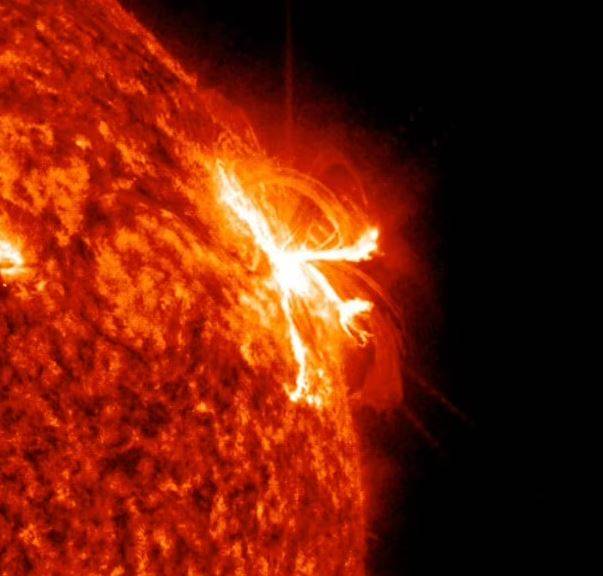NASA captures powerful flare exploding on sun's surface.

Stay tuned with 24 News HD Android App

The moment a powerful flare exploded on our sun's surface was captured by NASA's Solar Dynamics Observatory.
A strong X-class, which can be 10 times the size of Earth, was released from the blazing star's surface at 12:52 pm ET on March 3 and caused temporary shortwave radio blackouts in North and South America.
The blast of energy, which lasted for seven minutes, shot out from a sunspot called AR 3234, located at the top right region of the sun's surface, according to SpaceWeather.com.
The sunspot was first identified in February but has since quadrupled in size, according to NASA.
Aviators and ham radio operators may have noticed a signal loss and other unusual propagation effects at frequencies below 30 MHz for as much as an hour after the flare,' SpaceWeather reported on Friday.
'Solar radio bursts now being reported by the US Air Force suggest that the explosion may have also produced a CME.'
CME, or coronal mass ejection, is a stream of energetic, highly magnetized, superheated gas released from the sun.
CMEs can eject billions of tons of corona material from the sun's surface. The material consists of plasma and magnetic fields.
Such eruptions have the potential to trigger space weather that can interfere with satellites and power grids on Earth and can be harmful to unprotected astronauts.
NASA reported that its craft registered the flare as an X2.1, part of a class that can trigger radio blackouts worldwide and long-lasting radiation storms in the upper atmosphere.
And they can be up to 10 times the size of Earth, making them the largest kind of flares.
'The biggest X-class flares are by far the largest explosions in the solar system and are awesome to watch,' according to NASA.
Loops tens of times the size of Earth leap up off the sun's surface when the sun's magnetic fields cross over each other and reconnect.
'In the biggest events, this reconnection process can produce as much energy as a billion hydrogen bombs.'
When the massive flare smashed into our planet, it interacted with the atmosphere and caused a blackout lasting up to 30 minutes.
However, no significant issues happened as a result.
NASA also reported a separate solar flare last month, which broke off the sun's northern pole.
A video shows a giant filament of plasma, or electrified gas, shooting out from the sun, separating and circulating in a 'massive polar vortex.'
While astronomers are baffled, they speculate the prominence has something to do with the reversal of the sun's magnetic field that happens once every solar cycle.
Scientists have yet to determine what caused the filament in the recent observation to swirl around the sun instead of jetting out into space.
The recent increase in activity from the Sun results from it coming towards the most active phase in its 11-year solar cycle - hitting peak activity in 2024.
